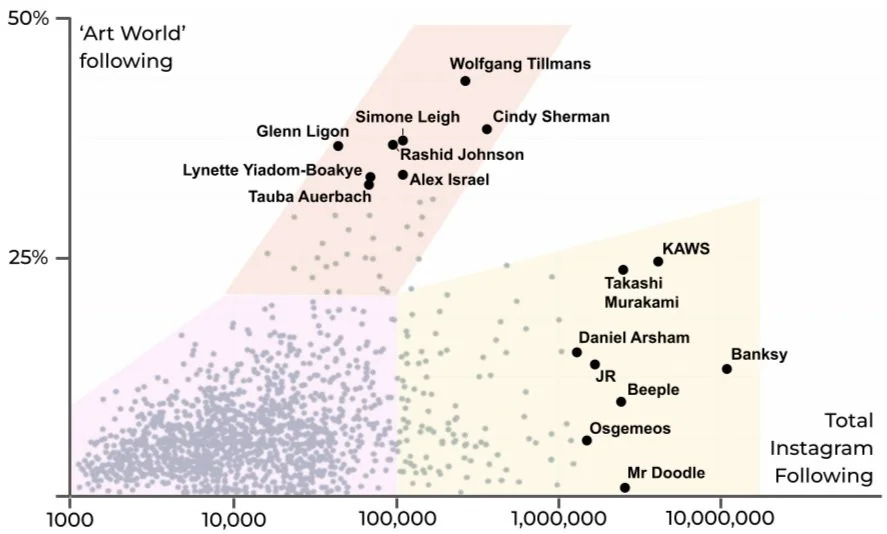A tale of two Art Worlds
Instagram data reveals which artists have the most influence in the 'attention economy' of the art market and the choice each must make - be respected or be popular.

With its image-focused user interface, which allows artists and other art professionals to express themselves ‘visually’ (rather than Twitter, which favours the verbose), Instagram is the dominant social media platform for the art world – by a long way. Collectors, dealers, curators, artists – they are all there, however begrudgingly in some cases.
The platform is particularly useful for discovering artists. According to a survey of 595 ‘art buyers’ done by the Hiscox Online Art Trade Report 2021, 71% of them use Instagram for art-related purposes, particularly for following and discovering artists to collect.
Since 2019, Critical Edge has been conducting research into the art world’s use of social media in order to better understand its shape and interactions. Part of that research has been to understand which artists the ‘insiders’ in the art world follow on Instagram, and highlighting how the art world’s values may differ from those of the wider Instagram audience (and the world at large).
By taking a sample of 5,000 prominent art-world insiders, we have ranked the 3,000 artists who are most followed by this sample group on Instagram. The sample group of ‘insiders’ are a mixture of collectors, curators, museum directors, dealers, and other art world professionals, from prominent museum directors like Klaus Biesenbach to ‘insider’s outsider’ curator Matthew Higgs and trendsetting dealers like Gavin Brown and Jeanne Greenberg Rohatyn (of LGDR).
The most followed artist within the ‘insider’ sample group was German photographer Wolfgang Tillmans, who is followed by 46% of the sample. In second place is another photographer, Cindy Sherman, with 43%. This isn’t a tremendous surprise as both artists are widely respected and valued by museums, collectors, and the market.
These top ‘insider’ artists do not, however, have a proportionately high number of followers in general. Most hover around the 100,000 mark – some higher, some lower. Glenn Ligon has just over 44,200 followers. Sherman has 366,000.
Nothing to be sniffed at, but small fry compared to the artists on Instagram with the greatest overall following – who all have audiences of over 1 million. At the top, Banksy commands 11.1m followers, followed by KAWS, Mr Doodle, Beeple and Takashi Murakami.
By comparing the top artists for the art world ‘insiders’ to the top artists by total following on Instagram, we can glimpse how the art world differs from the world at large. Or, to put it another way, the chasm that exists for artists between the art world of institutional validation, respect from peers, and the popular, high-demand, market-driven artists driven by social media, hype, and money.
This chasm can be seen in the very little correlation between ‘insider’ following and total following. We can observe two ‘paths’ taken by artists once they have passed a certain point in their career (audience growth), illustrative of two very separate systems of validation.
Looking at the cluster of artists with the highest overall follower count, we see the path to ‘fame’. Here are names that make headlines over and over in popular culture. Aesthetically, street art dominates within this group: think of figures such as Banksy, KAWS, JR, Osgemeos, Mr Brainwash and Mr Doodle. Mr Doodle is a useful example: his simple ‘graffiti spaghetti’, as he calls it, and his making-of videos are perfect for attracting engagement on Instagram.
These artists do not need the respect of museums, curators, galleries or even other artists, and many of them arguably don’t have it. They are followed by comparatively few art-world insiders, often in one concentrated region. The insiders following Mr Doodle, for example, are mostly art market actors in Asia. Only one curator within the insider sample follows him: the famously voracious Hans Ulrich Obrist.
Two of the most recognised ‘famous’ artists among ‘insiders’ are KAWS, who recently had an exhibition at the Serpentine in London, and Takashi Murakami, who has made a couple of appearances at the Venice Biennale.
The other path available to artists on Instagram is one of recognition by insiders over the general public. Among them are prominent US black artists like Simone Leigh, Rashid Johnson, and Glenn Ligon, whose works engage with social issues, politics and identity. The work of Tillmans and Sherman, though photographic, has a similarly conceptual bent. An interesting outlier in this group is Tauba Auerbach, known for her interdisciplinary explorations of structure, pattern and gesture.
The difference in the artists within these two groups might be unsurprising to some, but rarely has it been quantified using data in this way. This data clearly tells us that what the art world values does not necessarily correspond with the size of an artist’s ‘fame’ in the wider world. Or, to put it another way, what the art world recognises as valuable can be drastically out of sync with what the general public appreciates.
Moreover, as Instagram – emulating its younger cousin, TikTok – focuses more and more on video content, those choosing to follow the path taken by Mr Doodles and his peers will no doubt succeed even more. How are Simone Leigh and Lynette Yiadom-Boakye meant to compete? Should they even bother? Or just be satisfied with playing to the smaller, more selective art world?
Most importantly, perhaps, is what this means for the collector base now and in the future. If 71% of art buyers are using Instagram to discover new artists, this is clearly an issue worth thinking about.


